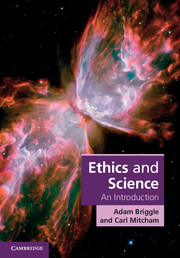Book contents
- Frontmatter
- Contents
- List of figures and tables
- Preface
- 1 Introduction and overview
- 2 Ethical concepts and theories
- 3 Science and its norms
- 4 Research ethics I
- 5 Research ethics II
- 6 Research ethics III
- 7 The science of ethics
- 8 Transition
- 9 Science and politics I
- 10 Science and politics II
- 11 Science and ideational culture
- 12 Science applied
- Epilogue Looking back, leaning forward
- Appendix Ethics codes
- Bibliography
- Index
- References
1 - Introduction and overview
Published online by Cambridge University Press: 05 November 2012
- Frontmatter
- Contents
- List of figures and tables
- Preface
- 1 Introduction and overview
- 2 Ethical concepts and theories
- 3 Science and its norms
- 4 Research ethics I
- 5 Research ethics II
- 6 Research ethics III
- 7 The science of ethics
- 8 Transition
- 9 Science and politics I
- 10 Science and politics II
- 11 Science and ideational culture
- 12 Science applied
- Epilogue Looking back, leaning forward
- Appendix Ethics codes
- Bibliography
- Index
- References
Summary
This book differs from many other introductions in philosophy, and even more so from those in science. It does not so much summarize existing knowledge – although it does some of that – as attempt to open a space for critical reflection on a spectrum of questions that were rarely asked until the late twentieth century. Philosophy and ethics deal with perennial questions, but here they are associated with new issues that nevertheless promise to become perennial in a world increasingly dependent on science and technology. By means of case references and interpretative arguments, the chapters that follow invite philosophical attention to the relationship between ethics and science, on the part of students and practitioners in the fields of both philosophy and science. The introductory chapter provides a quick intellectual geography of the terrain to be explored.
Setting the stage: the Manhattan Project
On August 2, 1939, Nobel Prize physicist Albert Einstein signed a letter (written by the Austro-Hungarian physicist Leó Szilárd) addressed to US President Franklin D. Roosevelt. The world’s preeminent scientist felt a moral responsibility to inform the president of recent developments in nuclear physics. Scientific advances had raised the possibility of creating nuclear chain reactions that could unleash vast amounts of energy. This new knowledge might lead to the construction of bombs more powerful than any previously imagined, and Einstein concluded that Nazi Germany might already be pursuing such weapons. Roosevelt responded with an initial allocation of US$6,000 for preliminary research. This was the beginning of what became the “Manhattan Project,” a massive, secret effort by the United States to build the atomic bomb. The project eventually employed 160,000 people working at centers in remote locations including Hanford, Washington; Knoxville, Tennessee; and Los Alamos, New Mexico. The push to build “the gadget” (as the scientist-engineers called it) was the most expensive research and development (R&D) project to that point in history.
- Type
- Chapter
- Information
- Ethics and ScienceAn Introduction, pp. 1 - 22Publisher: Cambridge University PressPrint publication year: 2012

